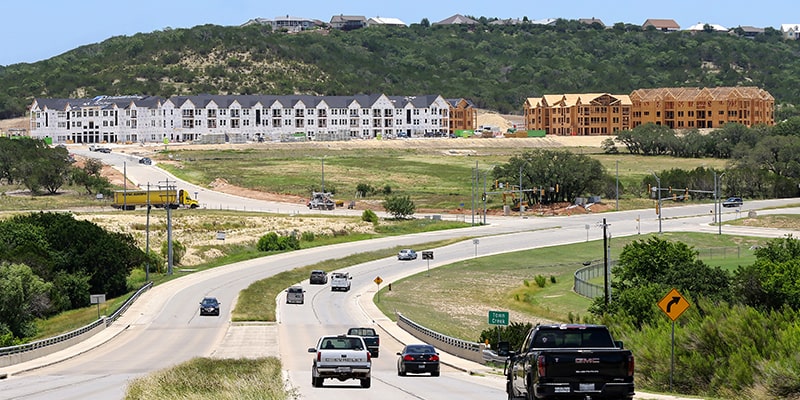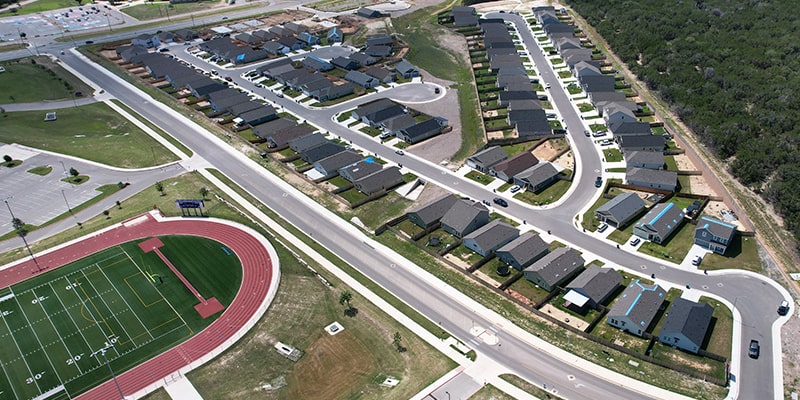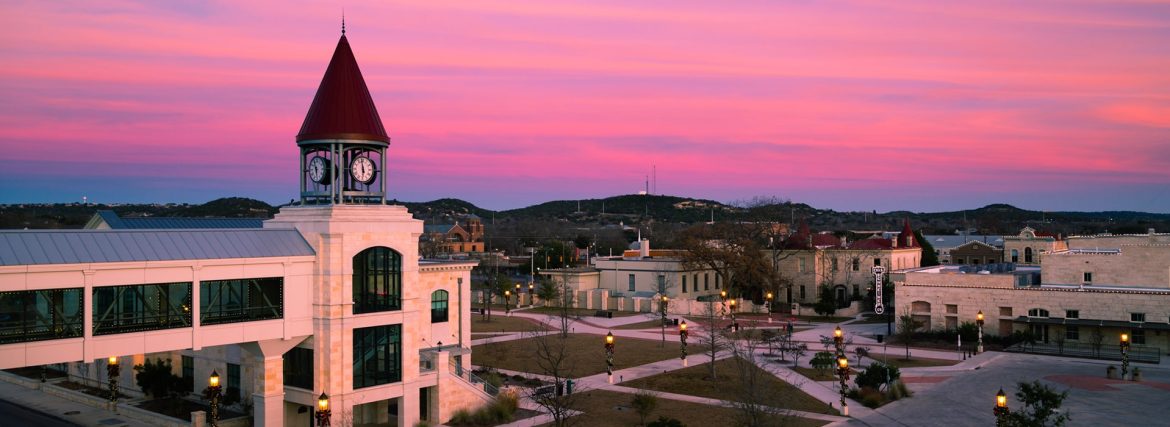A Community Shows Heart, Healing and Growth Through Joint Planning and Recovery Efforts Months After Deadly Floods
Even Amid Ongoing Disaster Recovery, Kerrville’s Citizens Remain Steadfast in Their Pursuit of Economic Growth. What’s Unfolding Now May Well Mark a Turning Point Unlike Anything Seen Since the Town’s Founding in 1889.
Perched in the Texas Hill Country, 65 miles northwest of San Antonio, Kerrville occupies a landscape where cypress-lined riverbanks meet rolling limestone hills. The city of 25,324 residents has earned a distinctive reputation since the Wall Street Journal described it in the mid-1990s as one of the wealthiest small towns in America. Yet for all its growth and prosperity, the community has preserved something increasingly rare: an authentic small-town character that transcends its population size.
“We still have a quintessentially small community feel,” says Dalton Rice, City Manager. “Everybody knows everybody. You run into someone you know everywhere you go – I can’t go to our local grocery store – HEB – without running into one of my kids’ coaches.”
Kelly Hagemeier, Economic Development Manager, notes that residents who relocate to Kerrville consistently cite the same attraction. “We find that a lot of residents who move here are attracted to the natural beauty, and our investment in our parks system attracts them here,” she explains. “We’ve seen in our various plans that preserving that beauty has an immeasurable value to our residents and those who visit are beautiful community.”
The Guadalupe River flows directly through the city, creating a network of parks and green spaces that define daily life here. Rice describes Kerrville as “a unique blend of everything” where scenic Hill Country vistas meet a vibrant downtown corridor. “We have a lot of park land, music festivals, city facilities and amenities and just things to do within the downtown area,” he adds. “There’s something for everybody.” This balance between natural amenities and urban convenience has created a community where residents enjoy sophisticated services without the overly urban or suburban feel that often accompany larger municipalities.
Rising from the Waters
On July 4, 2025, the Guadalupe River rose 26 feet in just 45 minutes, transforming a holiday morning into one of the deadliest inland flooding events in modern American history. At least 135 people died across Central Texas, with 107 confirmed deaths in Kerr County alone. The catastrophic flood claimed the lives of many young victims who were attending summer camp at Camp Mystic, destroyed homes and businesses, and left more than 160 people initially missing. Within weeks, through the efforts of over 1,000 responders, that number has dropped to just two.
“We’re 120 days out since the flood,” Rice says. “And we’ve been talking about what can be reimagined. How do we reimagine what we’re going to be, where we’re going to go and how we’re going to do things despite the devastation, despite the loss of life, despite everything that happened. For my team and the community, I want to focus on making our community as resilient, as mentally strong, and as improved as possible – to honor everyone who has come before us. There is an opportunity for us to reimagine how we’re going to move forward.”

The city organized its response into three categories: search and recovery, economic recovery, and debris management and rebuilding. Todd Bock, full-time executive director of Kerr EDC, explains the scope of the long-term recovery effort. “Through our leadership and our City Council and the County Commissioners, we have already stood up a long-term recovery group post-disaster, which consists of approximately 16 individual working groups that represent the county from far east to far west.”
Rice observes that recovery has progressed faster than typical post-disaster timelines. “This seems to be moving very quickly, and you’re right, it has been moving faster than other disasters, especially for the devastation,” he says. The rapid response points to the severity of the crisis and the strength of the community’s coordinated action.
From Direct Damage Support to Economic Ripple Effects
The flood’s impact on Kerrville’s business community involved more than the immediate waterline damage. Of approximately 265 businesses that reported being affected, 74 sustained direct flood impact. The West Kerr and Ingram areas bore the brunt, with youth camps, short-term rentals, and restaurants facing particularly acute challenges.
“We are working diligently with our business community especially those who are directly impacted at this time, to figure out what their needs are to get back up and running,” Hagemeier says. ” We are finding that the greater impact, outside of the immediate aftermath, is the economic impact that we’re going to see coming down the line and the shift, especially with tourism and what that future looks like for our business owners.”
Bock outlines the dual approach to business recovery. “We have a business recovery working group that has been working across the county along with the Kerrville Chamber of Commerce and Hunt Preservation Society and other Chambers of Commerce to get a grip on what the true economic needs are.” The group is implementing a rebuild program that will provide financial and material relief to businesses with direct flood damage, while case managers offer counseling and mentoring to help sustain operations.
The seasonal nature of Hill Country tourism adds complexity to the recovery timeline. Hagemeier notes concerns about impacts during the holiday season and next summer. Despite these challenges, Bock emphasizes that Kerr EDC’s core mission continues. “The focus of Kerr EDC will continue to be during and after disaster the business retention and expansion program, workforce development and diversification of our industry through attraction,” he says.
Housing Recovery and Rebuilding Lives
“The number of affected homes in Kerrville, fortunately for us, was limited,” says Michael Hornes, Assistant City Manager. “Most everyone was out of the flood plain and floodway. Speaking to the donations, I think one of the things you see is the amount of support we received nationally, and how many people have shown up for Kerrville. The amount of support that we’ve gotten is incredible.”
Habitat for Humanity is managing the eastern portion of recovery efforts through Kerrville, while Hunt Preservation Society handles western Kerr County. Bock confirms this division of responsibilities, noting the scale of volunteer engagement that immediately followed the disaster. Hornes describes the phased approach to housing restoration. “Immediately after the flood, there were a ton of volunteer groups that came in to help make the homes livable. They came in and they mucked out homes, they got rid of any mold, tore down the sheet rock, got out all the mud and the dirt and the debris, put drywall up and got those houses livable ready.”
The reality of construction costs shapes expectations. “A million dollars basically covers three homes,” Hornes says. “I’m old enough to know that sounds crazy. That doesn’t seem like enough homes, but that’s the world we live in now.” Yet ongoing housing developments including Lennar homes and the Bluewood apartments continue moving forward, with damage concentrated within 300 feet of the riverbanks on both sides.
Rebuilding Infrastructure, Parks, and Community Services
The flood’s assault on city infrastructure demanded swift action across multiple systems. Stuart Barron, Executive Director of Public Works and Engineering, describes the initial emergency response. “We had an emergency effort for about three weeks where we were fixing the water system, including broken water mains, getting our water treatment plant back online, and repairing bridges,” he says. “There weren’t too many streets that had gone out. We did have some asphalt damage here and there, but those were minimal compared to our utility issues.”

Wastewater systems faced particular strain as 28 lift stations contended with overwhelming rainwater. “A couple of lift stations went completely underwater, but we were able to get those all back up and running in a matter of about a week and a lot less time for most of them,” Barron notes. “We didn’t have a large period of time that we were out of service.”
Louise Hays Park, a central community gathering place, sustained severe damage. Rosa Ledesma, Assistant Director of Parks and Recreation, inventories the destruction. “We’ve got playground equipment that’s completely gone. The pavilions have been badly damaged. All the bathrooms have been demolished,” she says. Despite these losses, the park reopened quickly with temporary facilities. “Right now, we still have porta potties and some picnic tables that have been donated to us. We’ve had thousands of people using the park.”
Beyond physical infrastructure, the city established an emotional and spiritual care working group led by Pastor David Payne of First United Methodist Church. Bock emphasizes the broader philosophy guiding recovery. “We must heal ourselves first and we’re very resilient here in Texas, obviously, specifically speaking to the Texas Hill Country,” he says. “We do understand that we need to heal ourselves along with our river and our community.”
Economic Development and Workforce Partnerships
Major development projects continue advancing despite the flood’s disruption. Hornes announces a significant proposal headed to the next council meeting. “On the agenda is a tax increment reinvestment zone, our third, and this is a golf course development that we’ve been discussing for three years,” he says. “That community, which only consists of about 800 acres, is expected to have a 1.2 billion valuation when it’s fully built out, which is approximately 40 percent of our current property value.”
The project signifies substantial revenue potential across multiple streams. “It’s going to bring in property tax, it’s going to bring sales tax, it’s going to bring hotel occupancy tax,” Hornes adds. “The development team have said for the last 90 days, we’re here for Kerrville, we’re Team Kerrville, which feels great.”
Melissa Allen, Director of the Center for Talent and Workforce Development (CTWD) at Schreiner University, describes the partnership approach to workforce needs. “We met yesterday and had an hour-long conversation about just how we can provide some immediate assistance. What does that look like and where is the most immediate need, forms of training,” she says. “We have been in constant contact recently to make sure that as CTWD, that we know what’s going on and we can be there if there are needs we can meet.”
Preparing for the Future
The absence of an adequate flood warning system became painfully clear during the disaster. Historical records show the Guadalupe River has experienced major flooding more than a dozen times in the last century, yet Kerr County lacked the infrastructure to provide timely alerts. The Upper Guadalupe River Authority had submitted grant applications in 2017 and 2018, both denied, and in October 2024 declined to pursue further funding after learning the project would only qualify for a 5 percent grant.
Bock announces a major priority emerging from the recovery effort. “One of our working groups is the Guadalupe River Flood Warning System, that is led by Tara Bushnoe of UGRA. Ms. Bushnoe, along with City and County and the City of Ingram and our emergency services districts to develop a gold standard sub-basin warning system for the Guadalupe River Basin and County,” he says. “The goal is to have portions or all of that implemented by June of 2026.”

Hornes confirms the state’s backing for the initiative. “That’s also one of the governor’s priorities for us. The State of Texas is behind Kerr County in that effort to help us prop up a good warning system,” he says. “There’s a large contingent of people from emergency services, the camps themselves, the various civic groups all the way up and down the river communicating to find the best solution, the correct solution.”
Rice reflects on the path forward three months after the catastrophe. “We have an amazing team doing a lot of amazing work, and we’re going to get through this, we’re going to reimagine where we can go and how we’re going to get there,” he says. The question facing Kerrville is no longer whether it will recover, but how it will emerge stronger from one of the darkest chapters in its history.
This was at the request of the governor, but the Community Foundation designated that portion of their $100M for housing
Is there information or a quote about County housing recovery that could be added here?
AT A GLANCE
Who: City of Kerrville, Texas
What: A Hill Country city of 25,324 residents, county seat of Kerr County, recognized for its natural beauty, small-town character, and diverse economy spanning healthcare, manufacturing, tourism, and education
Where: Texas Hill Country
Website: www.kerrvilletx.gov
PREFERRED VENDORS/PARTNERS
J Street: www.jstreetps.com
yers Residential, the development arm of J Street Property Services, is a Texas-based multifamily firm dedicated to building walkable, mixed-use communities. With deep local expertise, a “Main Street over Wall Street” mindset, and the strength of J Street’s proven property management platform, we develop and own high-quality, attainable housing and enduring value through thoughtful design, strong partnerships, and disciplined execution.
Kerrville Area Chamber of Commerce: www.kerrvillechamber.biz
Through devastation, our Texas community stands strong. The Kerrville Area Chamber of Commerce Foundation Rebuilding & Recovery Fund supports local businesses as they rebuild and reopen after the July 4th flood. Please donate to help restore livelihoods, strengthen our economy, and bring hope back to Kerrville, Texas. Donate today—rebuild tomorrow.
Ken Stoepel Ford Inc.: www.stoepelford.com
Ken Stoepel Ford is a family-owned and operated dealership that has been serving Kerrville, Texas since 1966. With a contributor list of over 200 local organizations, you won’t find another dealership who cherishes and supports Kerrville and its surrounding community more! We are Hill Country Proud
HCTC: www.hctc.net
HCTC is known for being ruthlessly reliable, obsessively customer-driven, and technologically fearless during our 75 years of being a Texas Cooperative. We are also the quiet, indispensable, resilient infrastructure partner that keeps operations online, customers loyal, and the videos flowing at your child’s birthday party.





